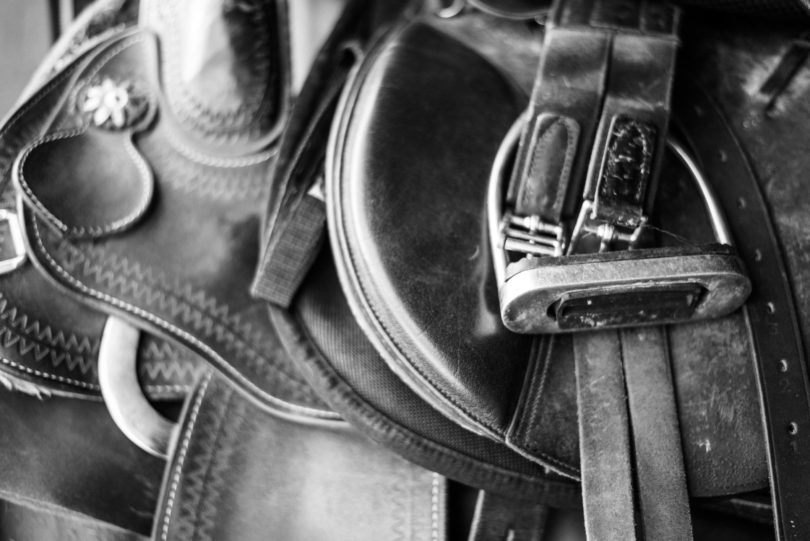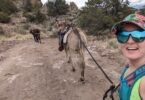Switching between English and Western riding is easy–if you’re properly equipped
“Do you ride English or Western?” is often one of the first questions people ask when I mention owning a horse. My answer is a joyful, “Yes!”
While I have one horse I have far more than one interest. It’s a major reason I bought a Quarter Horse, a breed notorious for its versatility and can-do attitude.
Within the past 30 days, alone, my gelding has switched between:
- Jumping
- Cutting
- Dressage
- Reining
- Quadrille
- Packing out an elk
During warmer months, his repertoire expands to:
- Ranch Riding
- Working Equitation
- Roping
- Three-Day Eventing
- Reined Cow Horse
- Trail Riding
So when I call myself a multi-discipline rider, I mean it in the truest sense of the phrase.
Pros & Cons of Crossing the Line
There are many benefits for an equestrian “doing it all.” For example:
- You never get bored because you learn about different topics.
- You meet more people and experience more points of view.
- Your horse becomes more well rounded physically and mentally.
- Your position becomes stronger and more adaptable.
- You have more fun!
Yet, crossing the English/Western line comes with unique challenges that our single-discipline counterparts don’t face.
- We must ride a horse that’s physically and mentally able to handle constant change.
- We require different horse equipment and horse riding gear for different activities.
- We search for versatile horse riding essentials that can be used across several disciplines.
- We accept that many items can’t span the English/Western divide.
- We need every dollar to stretch even further.
Multi-Discipline Must Haves
Over the years, I’ve purchased a lot (*understatement*) of gear and apparel. Some items have stood the test of time, while others quickly found their way into the consignment room at my local tack store.
In this article, I share six no-regrets essentials that should be on every multi-discipline horse rider’s wish list.
1. A Helmet You Can Trust
Whether I’m fencing a cow or jumping an oxer, there’s a Tipperary Sportage helmet on my head — every ride, every time. A concussion or traumatic brain injury keeps you out of the saddle (or worse), and it’s simply not worth the risk.
Many Western riders still choose not to wear helmets, and it’s not uncommon for me to be the only person wearing one at cow working clinics and shows. Luckily, that trend is changing as popular riders like barrel racer Fallon Taylor educate the public about “protecting their melons.”
Why it’s worth it:
- ASTM-SEI certified helmets offer the highest level of protection.
- Ventilation system supports increased circulation and air flow.
- Streamlined design and classic colors look great with English and Western apparel.
- Lower back shell protects more of your head and keeps the helmet in place.
- So lightweight (17 ounces!) and comfy that you’ll forget you’re even wearing it.
What to keep in mind:
- You may be outnumbered by the “cowboy hat crowd” at Western events.
- Helmets should be replaced immediately if they’re involved in a fall, or every five years if not.
2. Paddock Boots & Half Chaps
If you’re not careful, you’ll end up with a closet-full of boots you can only ride for English OR Western activities — but not both.
That’s why a high-quality pair of paddock boots and half chaps are two of the best investments multi-discipline riders can make. Paddock boots and half chaps can seamlessly transition between English and Western arenas. (Just remember to swap your spurs!)
Learn more about why I love my versatile Ariat Heritage Lacers and ventilated half chaps.
Why it’s worth it:
- Paddock boots are cooler than tall boots in hot weather and easier to get on/off year-round.
- Safety heels, quality leather, and cushioned soles make short boots practical and comfy.
- Half chaps provide inner-leg grip with any type of saddle and protect your pants from wear.
- Many half chaps feature stretchy panels so you can wear them over breeches, tights, and even skinny jeans.
- If you coordinate colors and styles, paddock boots with half chaps can give the appearance of classic tall boots in the saddle.
What to keep in mind:
- If you plan to show, double-check the rules — some disciplines require cowboy boots or dress boots for competition. (For schooling shows, you’ll be fine!)
- Avoid trudging through deep sand arenas without half chaps, or you’ll end up shaking dirt out of your boots and socks later.
3. Electrolyte Supplements
We ask a lot of multi-discipline horses, and it’s our responsibility to make their (many) jobs easier. One of the best things we can do is offer a quality electrolyte supplement that helps promote healthy hydration and replenish the electrolytes horses lose during daily activity.
After noticing my horse was struggling to recover as quickly after summer workouts a few years ago, I put him on a daily electrolyte supplement. The improvement was almost immediate, which is why electrolyte powder still periodically appears in my monthly horse expense reports.
Why it’s worth it:
- Electrolyte supplements are inexpensive and easy to add to daily feed rations.
- Encourage water consumption, boost appetite, and support healthy nerve/muscle function.
- May perk up horses that tend to act more lethargic during hot weather workouts.
- Designed to help performance horses recover from activity more quickly.
- No sugar, fillers, or artificial colors are used in this apple-flavored product.
What to keep in mind:
- Always talk with your vet and/or trainer before making any changes to your horse’s diet.
- Some horses only need electrolyte supplements during warmer months, while others benefit from year-round feeding. (Again, check with your vet.)
4. Wool-Blend or Fleece Cooler
I love spending time with at the barn, but that doesn’t mean I want to wait around all evening for my horse’s coat to dry after a hard workout. A contour cooler allows me to run reining patterns, school jumping grids, take a long ride, or work cows in cold weather without dreading the cooldown.
A cooler wicks away post-exercise sweat from your horse’s coat and speeds up the drying process significantly. If you’re schooling away from home or showing, take a cooler along so your horse doesn’t become chilled between events or on the drive home.
Why it’s worth it:
- You can spend more of your time riding instead of standing around waiting for your horse to dry.
- Contour-cut coolers are more comfortable around the horse’s shoulders, check, and neck.
- Full-neck design ensures the entire horse dries more quickly, not just it’s core.
- Wool and wool-blend fabrics stay warm while they wick moisture away from the coat.
- Adjustable surcingle straps, hook and loop front closure, and detachable tail cord help it fit a wider range of body types and sizes.
What to keep in mind:
- If you use a fleece cooler, remove it immediately once it becomes moist. Fleece fabric becomes cold when wet, while wool does not.
- You may also want to invest in a few blankets and sheets to keep your horse more comfortable in the winter. Learn more about the best horse blankets for winter, turnout, and rain.
5. Ventilated Long-Sleeve Riding Shirt
Finding apparel you can year all year for any discipline is rare, but not impossible. Ventilated long-sleeve riding shirts are worth every penny, and I have at least five in my closet.
I was initially resistant to wearing long-sleeve shirts in the heat of summer, but I’ve changed my tune in recent years. Riders need to protect themselves from the sun damage, and cooling fabric lowers your body temperature more than short-sleeve cotton shirts or tank tops.
Why it’s worth it:
- Strategic mesh panels on the back and under the arms maximizes breathability.
- Opti-Dri technology wicks away moisture.
- Stand-up collar and long sleeves protect you from the sun.
- Form-fitting design is flexible, flattering, and comfortable for all body types.
- Suite of classic and bright colors are suitable for English and Western sports.
What to keep in mind:
- Choose your shirt style and color based on whether you’re looking for a schooling shirt or competition apparel.
- Some ventilated riding shirts feature SPF sun protection in the fabric, but others don’t.
6. Woof Wear Brushing Boots
One of the most common struggles multi-discipline riders have is choosing which boots to buy for their horses. I have everything from bell boots to combo performance boots, open front jumping boots to skid boots.
The most versatile horse boots I’ve found, however, are Woof Wear Brushing Boots. Not only have they lasted more than three years without any noticeable wear and tear, they’re suitable for many activities. From
Why it’s worth it:
- Provides basic leg protection for a wide range of disciplines.
- Incredible craftsmanship holds up to heavy use for years.
- Helps protect against bone concussions, impact, and brushing.
- Breathable neoprene is lightweight and won’t retain water.
- PVC strike pads offer optimal protection.
What to keep in mind:
- These boots run a bit on the small side, so you may want to size up.
- Woof Wear Brush Boots are sold in pairs, and you’ll likely need one size bigger for hind legs.
Frequently Asked Questions
Can a horse be trained English and Western?
The majority of riders pick a single discipline — or several that stay within either the English or Western arena.
That said, cross-over riders and horses DO exist, and you can train your horse to switch between them. (I did!) If you want to “do it all” with a single horse, though, you’ll need to be patient — with your horse and yourself.
Is English or Western riding better for the horse?
Every horse is different, and so is every rider. Your horse may love barrel racing but hate jumping. Or you may adore trail rides and abhor the show ring.
The most important thing is to choose the activities that suit you both the best.
Do Western riders jump?
Typically, no Western riders don’t spend time jumping. The saddle horn on a Western saddle isn’t made for jumping, and it can be painful to do a correct two-point jumping position — especially when you’re landing!
One exception is in some ranch riding and trail classes, where horses may be asked to jump over a very small obstacle as part of their course.
What should I wear when working with horses?
Apparel varies based on what you’re doing around horses, but generally you’ll want to wear:
- Boots with a closed toe
- Long-sleeve shirt
- Jeans or breeches
- Baseball or cowboy hat (unmounted) or a helmet (mounted)
Learn more about what to wear horseback riding.
Parting Thoughts
Don’t limit yourself, or your horse, from trying new things. Both of you may find that there is more to learn and enjoy by branching out of your comfort zones!
P.S. Enjoy this article? Trot on over to:
- Horse care 101: Turnout blankets vs. stable blankets
- Ranch Roundup: 10 Best Horseback Riding Vacations in Montana
- 20 Different Types of Western Riding (With Videos)
- Shelby Dennis: Best Horse Riding Advice & Biggest Rookie Mistakes
- Horse Jumping Tips Beginners Can Put Into Practice Today
- 3 Creative Ways to Afford Horse Riding Lessons













